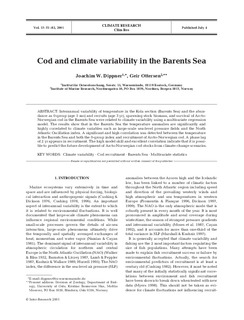| dc.contributor.author | Dippner, Joachim W. | |
| dc.contributor.author | Ottersen, Geir | |
| dc.date.accessioned | 2007-06-20T09:21:02Z | |
| dc.date.issued | 2001 | |
| dc.identifier.citation | Climate Research, 17(1), 2001:73-82 | |
| dc.identifier.issn | 0936-577X | |
| dc.identifier.uri | http://hdl.handle.net/11250/108388 | |
| dc.description.abstract | Interannual variability of temperature in the Kola section (Barents Sea) and the abundance as 0-group (age 5 mo) and recruits (age 3 yr), spawning stock biomass, and survival of Arcto-Norwegian cod in the Barents Sea were related to climate variability using a multivariate regression model. The results show that in the Barents Sea the temperature anomalies are significantly and highly correlated to climate variables such as large-scale sea-level pressure fields and the North Atlantic Oscillation index. A significant and high correlation was detected between the temperature in the Barents Sea and both the 0-group index and recruitment of Arcto-Norwegian cod. A phase lag of 2 yr appears in recruitment. The high model skill and excellent correlation indicate that it is possible to predict the future development of Arcto-Norwegian cod stocks from climate-change scenarios. | en |
| dc.format.extent | 526614 bytes | |
| dc.format.mimetype | application/pdf | |
| dc.language.iso | eng | en |
| dc.subject | cod | en |
| dc.subject | torsk | en |
| dc.subject | climatic conditions | en |
| dc.subject | klimaforhold | |
| dc.title | Cod and climate variability in the Barents Sea | en |
| dc.type | Journal article | en |
| dc.type | Peer reviewed | |
| dc.source.pagenumber | 10 s. | en |
| dc.source.volume | 17 | en |
| dc.source.journal | Climate Research | |
